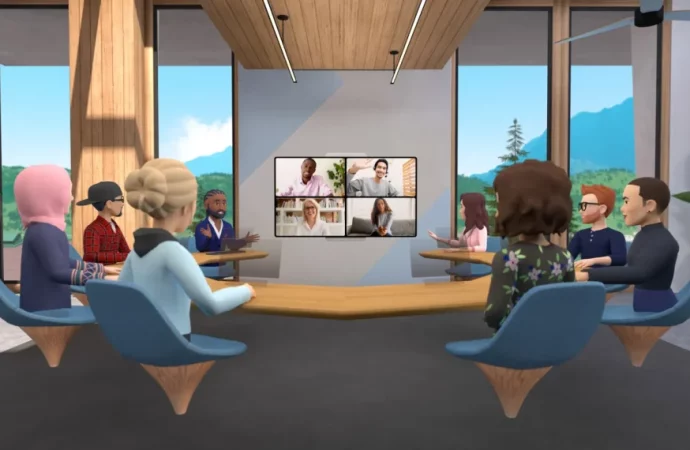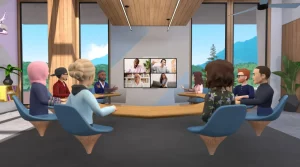The advent of the metaverse has ushered in a new era of connectivity and collaboration, transforming the traditional landscape of office meetings. With virtual reality (VR) and augmented reality (AR) technologies becoming increasingly sophisticated, the concept of virtual meetings has evolved from a futuristic fantasy to a tangible reality. This shift has profound implications for
The advent of the metaverse has ushered in a new era of connectivity and collaboration, transforming the traditional landscape of office meetings. With virtual reality (VR) and augmented reality (AR) technologies becoming increasingly sophisticated, the concept of virtual meetings has evolved from a futuristic fantasy to a tangible reality. This shift has profound implications for how individuals and organizations conduct business, offering opportunities for enhanced productivity, flexibility, and inclusivity. In this article, we delve into the dynamics of meetings in the metaverse, exploring the benefits, challenges, and future prospects of this burgeoning trend.
The Rise of Virtual Offices
Virtual offices, once relegated to the realm of science fiction, are now a tangible manifestation of technological innovation. These digital workspaces replicate the physical office environment in a virtual realm, complete with conference rooms, collaborative tools, and customizable avatars. By leveraging VR and AR technologies, remote workers can immerse themselves in these virtual environments, transcending geographical barriers and fostering real-time interactions with colleagues from around the globe. This shift towards virtual offices reflects the growing demand for flexible work arrangements and the need to adapt to an increasingly digital-centric world.
Benefits of Virtual Meetings
The transition to virtual meetings offers a myriad of benefits for both individuals and organizations. Firstly, it enables greater flexibility and accessibility, allowing participants to join meetings from anywhere with an internet connection. This eliminates the need for extensive travel and accommodation, reducing costs and environmental impact. Moreover, virtual meetings promote inclusivity by accommodating individuals with disabilities or mobility restrictions, ensuring that all team members can actively participate regardless of their physical location.
Furthermore, virtual meetings facilitate seamless collaboration and knowledge sharing through immersive multimedia experiences. Participants can share documents, presentations, and 3D models in real-time, enhancing engagement and comprehension. Additionally, the integration of spatial audio technology creates a sense of presence and spatial awareness, mimicking the dynamics of face-to-face interactions. This immersive environment fosters creativity and innovation, driving productivity and problem-solving capabilities.
Challenges and Considerations
Despite its numerous advantages, the adoption of virtual meetings presents its own set of challenges and considerations. One of the primary concerns is the potential for technological barriers and disparities in access. Not all employees may have access to the necessary hardware or high-speed internet connection required for a seamless virtual experience. This digital divide can exacerbate inequalities and hinder effective communication within teams.
Moreover, virtual meetings may pose privacy and security risks, particularly concerning the collection and storage of sensitive data. As participants interact within a virtual environment, there is a need to safeguard confidential information and ensure compliance with data protection regulations. Additionally, maintaining professional etiquette and mitigating distractions in virtual meetings requires a level of adaptability and digital literacy among participants.
Future Outlook and Implications
Looking ahead, the integration of virtual meetings into mainstream work culture is poised to reshape the dynamics of collaboration and communication. As technology continues to advance, the boundaries between the physical and digital realms will blur, enabling more immersive and interactive experiences. Virtual reality headsets, once considered niche gadgets, may become ubiquitous tools for professional networking and collaboration.
Furthermore, the metaverse holds promise for enhancing remote work practices and addressing the challenges of distributed teams. By creating virtual replicas of physical office spaces, organizations can foster a sense of belonging and camaraderie among remote employees. This hybrid approach to work allows individuals to reap the benefits of both in-person interactions and remote flexibility, striking a balance between productivity and well-being.
Analysis Table:
| Aspect | Virtual Meetings in Metaverse |
|---|---|
| Flexibility | Enables participation from anywhere with an internet connection |
| Accessibility | Promotes inclusivity for individuals with disabilities or mobility restrictions |
| Collaboration | Facilitates real-time sharing of documents, presentations, and 3D models |
| Engagement | Enhances engagement through immersive multimedia experiences |
| Privacy and Security | Raises concerns regarding data protection and confidentiality |
| Technological Barriers | Highlights disparities in access to hardware and internet connectivity |
| Professional Etiquette | Requires adaptation to virtual communication norms and etiquette |
Comparative Table:
| Aspect | Virtual Meetings | Traditional Meetings |
|---|---|---|
| Location | Anywhere with internet | Physical office or specified location |
| Travel Requirements | None | Often involves travel |
| Environmental Impact | Reduced carbon footprint | May contribute to emissions |
| Cost | Lower costs for travel and accommodation | Higher costs for travel and logistics |
| Inclusivity | Accommodates individuals with disabilities | Potential barriers for mobility-impaired individuals |
| Engagement | Immersive multimedia experiences | Limited to visual and auditory stimuli |
| Collaboration | Real-time sharing of documents and 3D models | Relies on physical handouts and whiteboards |
| Productivity | Enhances creativity and problem-solving | Subject to distractions and interruptions |
Conclusion
Meetings in the metaverse represent a paradigm shift in how individuals and organizations collaborate and communicate in the digital age. By harnessing the power of virtual reality and augmented reality technologies, virtual meetings offer a compelling alternative to traditional face-to-face interactions. While challenges such as technological barriers and privacy concerns persist, the benefits of flexibility, accessibility, and enhanced collaboration outweigh the drawbacks. As we navigate this evolving landscape, embracing the opportunities afforded by the metaverse can empower us to redefine the future of work and foster a more connected and inclusive global community.























